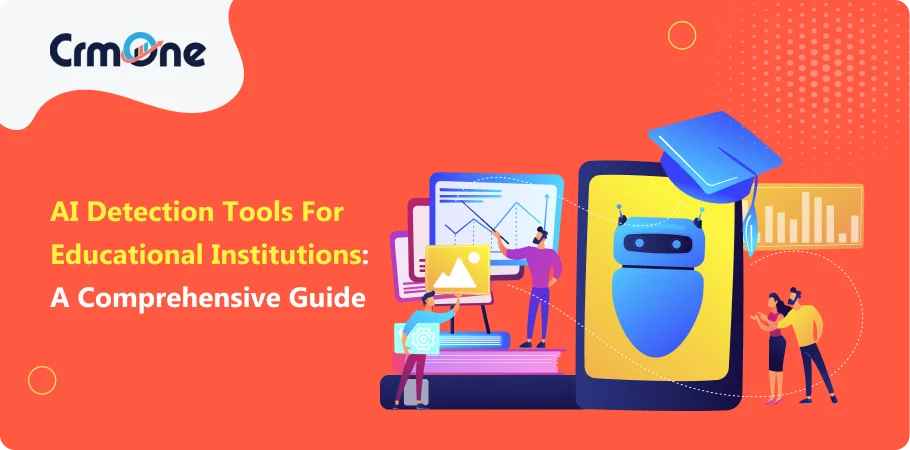We are not wrong when we say that artificial intelligence has made our lives easier and more productive. It has made us work smarter and more efficiently. Ai tools have made a big impact in educational institutions. It has made research easier. Not only that it has ai models have helped students big time in content ideation, writing better essays etc. Even teachers are benefiting from ai writing tool.
But we should never forget that this ai generated content is part of a system. It is still machine-generated, and human creativity will always be supreme. Yes, ai generated text is good for students, but, it is good to a point when we are not entirely dependent on it. Creative capacity should never be lost and we should be mindful of the use of AI. Not only that as a student if you are completely dependent on AI for your blog, it will also affect your Google search rankings.
So human-written and human-generated content should be fostered and valued in an academic environment. The fine line between originality and insight shows the need for AI detection tools in educational institutions. These tools are about detecting ai generated content and ensuring that students use of AI enhances not replaces their learning process. AI detection tools can also detect ai generated images, videos and audio, showing its full capabilities. As we explore the 10 best AI detection tools for educational institutions, we will see how each can help in maintaining this balance, so AI is a complement not a substitute for human intellect and creativity.
What are AI Detection Tools?
AI detection tools are special software that detects content generated by artificial intelligence (AI) in educational settings. These tools help to distinguish between student’s work and ai generated work. They make sure that the content submitted by students is theirs alone which is very important in academic settings where originality and individual effort is highly valued.
There are many benefits of ai detection tools. Some of them are:
- Promotes Authentic Learning: AI detection tools ensure that students are engaged in genuine learning. By detecting ai generated content, these tools encourage students to develop their own ideas and understanding, which is important for their intellectual growth.
- Maintains Academic Honesty: By distinguishing between human written and ai written content, these tools maintains the standards of academic honesty. It prevents plagiarism and misuse of AI in submitting assignments, thus upholding the value of each student’s individual effort.
- Develops Critical Thinking: The use of AI content detectors in academic settings makes students rely on their critical thinking and problem-solving skills instead of using AI for quick answers.
- Supports Educators: AI detection models provides teachers with a way to verify the authenticity of students’ work. This support enables educators to focus more on teaching and less on policing the assignments.
- Verifiable Academic Records: With the use of AI detectors to detect ai generated content, educational institutions can guarantee the integrity of their academic records. This is very important as students move to higher education or professional fields where their academic background is being checked.
By using these tools, educational institutions can use the benefits of AI while learning remains human created and intelligent.
10 Best AI Detection Tools for Educational Institutions
1) Surfer AI Content Detectors
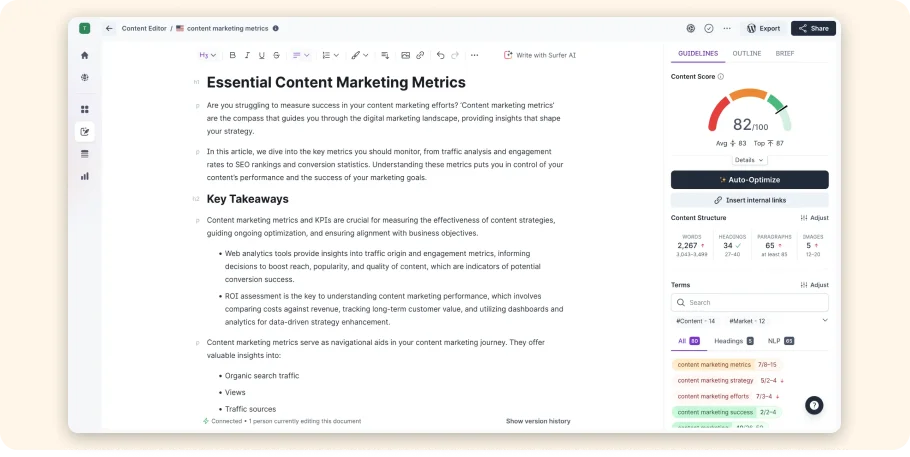
Surfer AI Content Detector detects text and ai generated content for academic integrity.
Features:
- Advanced Detection Algorithms: Uses complex machine learning algorithms to analyze writing patterns that distinguish human writing from ai generated text.
- Compatibility Check: Integrates with most educational platforms and can process multiple file formats.
- Report Generation: Generates detailed reports with percentages indicating the ai involvement so educators can make informed decisions.
Pros: High accuracy; bulk upload for classroom management.
Cons: Can trigger false positives on complex texts.
Pricing: Subscription based with free trial; pricing varies based on institution size and usage.
Boost Your Business Performance with CrmOne
Our experts will guide you through the most effective ways to use CrmOne, ensuring you fully leverage its features for maximum impact on your business.
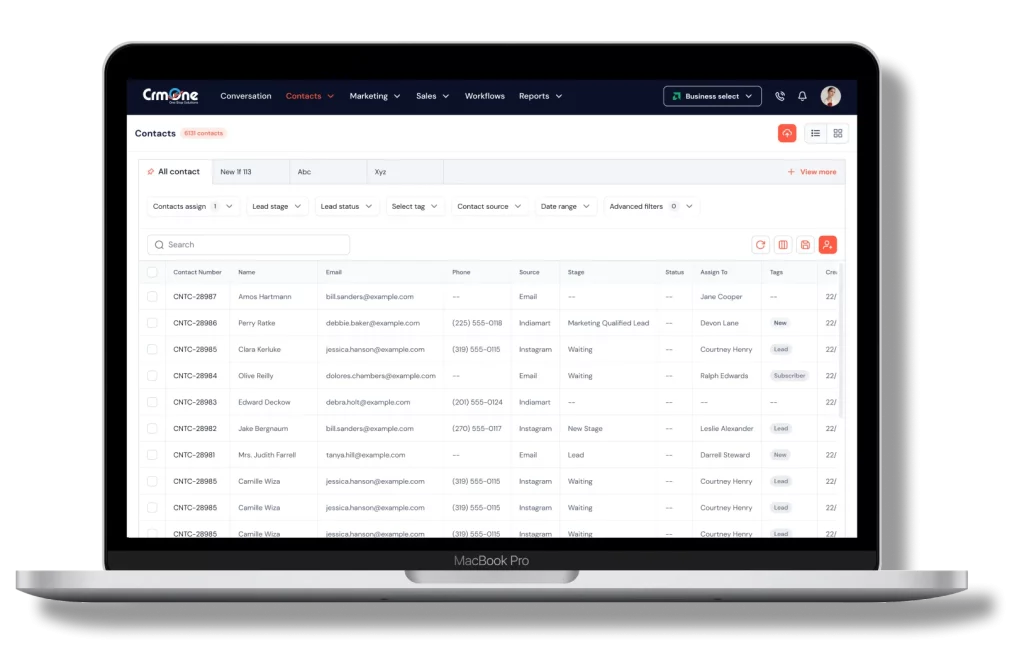
2) QuillBot’s AI Detector
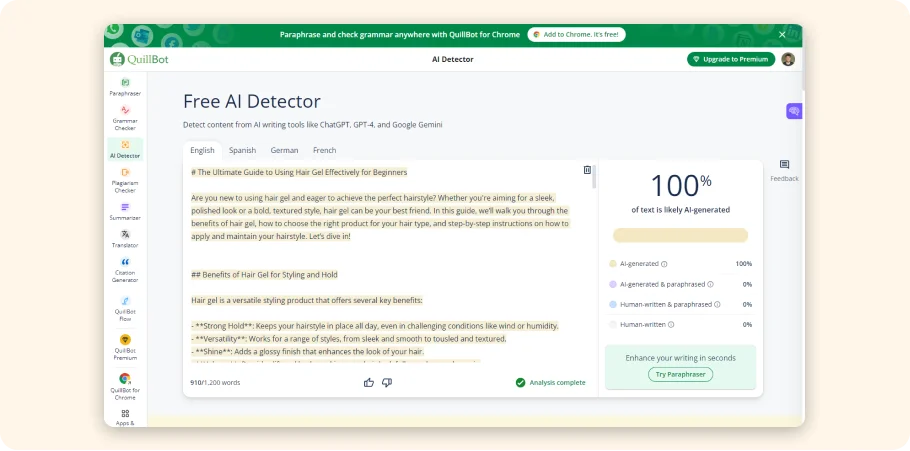
If you want a useful and trustworthy tool then QuillBot is perfect. It analyzes sentence style to find out whether it is human-written or AI-generated.
Features:
- Style Analysis: Analyzes the stylistic elements of the text to detect unnatural patterns found in ai generated content.
- Real-time Feedback: Provides real-time analysis and feedback on the content which is very useful for interactive learning environments.
- Integration: Integrates with LMS used by educational institutions.
Pros: User friendly interface for students and teachers.
Cons: May misclassify creative or technical human written content as ai generated.
Pricing: Free plan and paid plans with additional features.
3) Grammarly
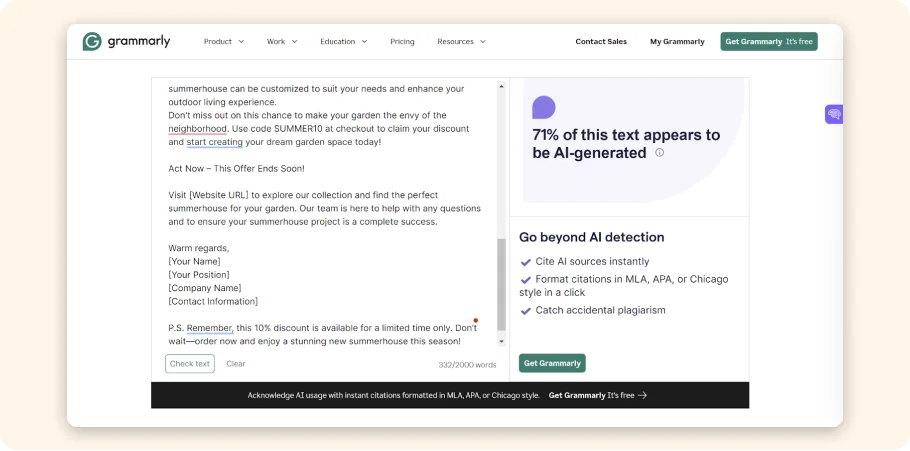
Grammarly is famous for its writing tool but also has features to detect plagiarism and it is one of the best ai tool for writers.
Features:
- Advanced Editing Tools: Besides grammar and spell check, it analyzes sentence structure and writing style to flag content that doesn’t sound like human writing.
- Plagiarism Checker: Has a plagiarism checker that compares text against a huge database of content across the internet including ai generated content.
- Personalized Writing Insights: Provides insights to the writing style which can help in identifying patterns or anomalies of ai intervention.
Pros: Improves overall writing quality and content integrity.
Cons: Premium features, including advanced checks, have a cost.
Pricing: Free basic service, premium service through monthly subscription.
4) AI Text Classifier
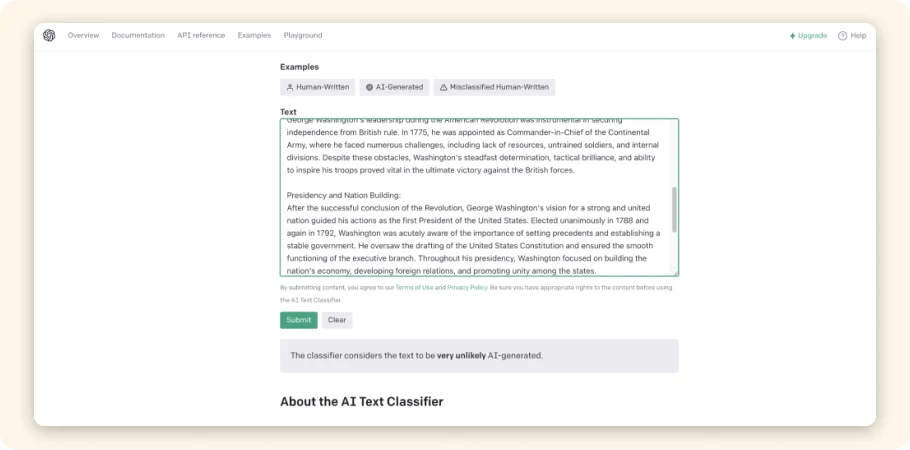
A tool specifically designed to classify and detect ai text through deep learning.
Features:
- Deep Learning Frameworks: Uses latest deep learning techniques to understand and detect patterns of ai authorship. The AI Text Classifier can be compared to GPT-2 Output Detector which has 58% accuracy and has a simple interface.
- Custom Model Training: Allows institutions to train the model on specific writing styles or formats used in their curriculum to improve detection.
- Scalability: It can handle large volumes of text, so it is suitable for big classes or institutions.
Pros: Accurate and can adapt to new ai writing styles as they emerge.
Cons: Requires technical setup and management.
Pricing: Custom pricing based on the institution’s needs and scale.
5) Copyleaks
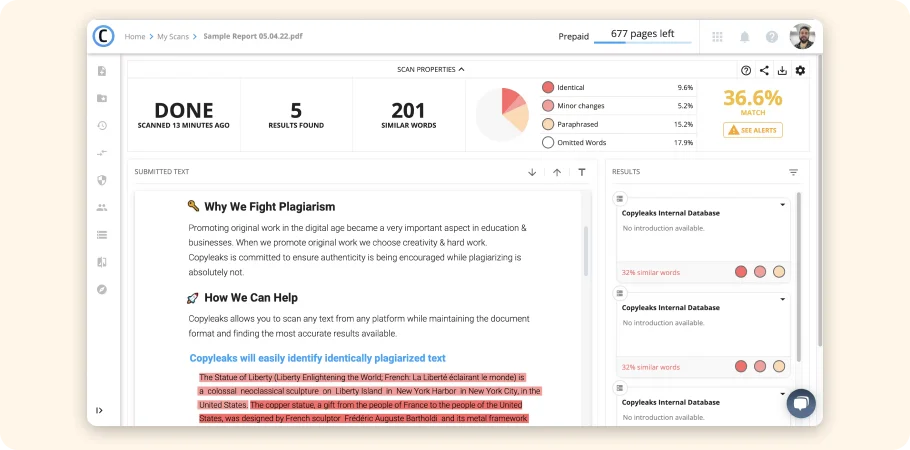
A plagiarism detection tool, Copyleaks also detects ai generated content.
Features:
- Comprehensive Database Search: Checks text against a huge database to find not only plagiarized content but also patterns of ai generated text.
- API Integration: Has an API for integration with educational tools and platforms.
- Multilingual Support: Can analyze content in multiple languages which is useful for diverse educational settings.
Pros: Has extensive support and documentation; robust detection.
Cons: It can be more expensive than others, especially for full features.
Pricing: Offers plans based on number of pages to be scanned and features needed.
6) ZeroGPT
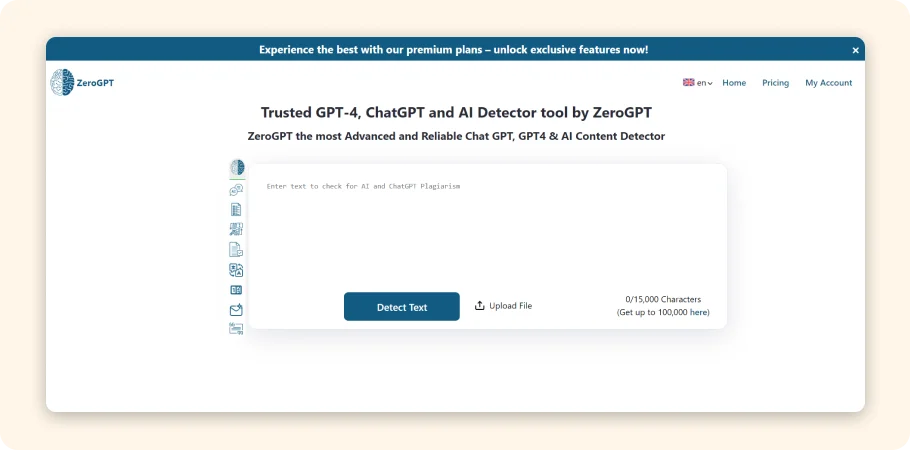
ZeroGPT’s ai content detector is designed to detect human written text and ai generated content to maintain academic integrity.
Features:
- Content Analysis: Uses AI detection models to check for signs that the content might be AI generated so students’ work is original.
- Ease of Use: User friendly so educators and students can quickly check text.
- Integration Capabilities: Can integrate with educational platforms to streamline detection.
Pros: Can detect subtle ai written text.
Cons: May need to be updated to keep up with new ai writing tools.
Pricing: Has a free basic version and a premium version with advanced features.
7) Honorlock
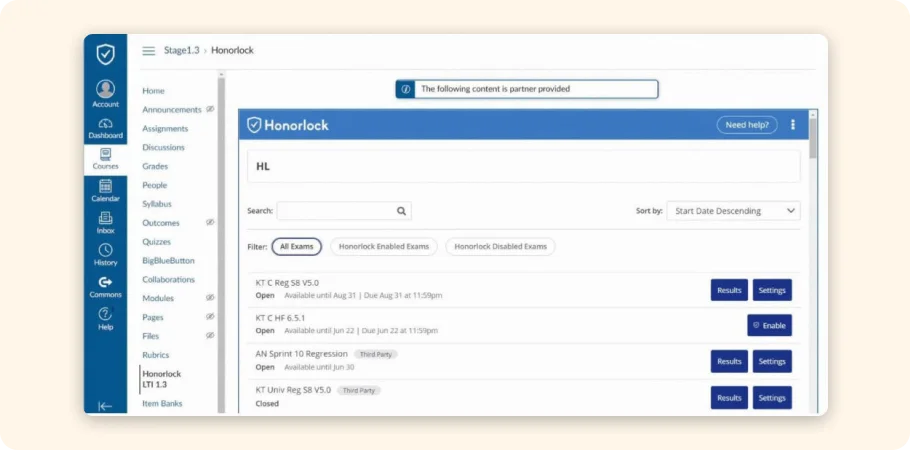
Honorlock combines test proctoring with ai content detection to ensure academic integrity.
Features:
- Proctoring Integration: Integrates proctoring service with ai detection to prevent cheating during exam.
- Real-time Detection: Monitors and flags content in real-time, provides instant feedback.
- Comprehensive Dashboard: Gives educators a complete view of test integrity and ai usage.
Pros: Dual functionality for security and content integrity.
Cons: More suitable for exam settings than regular coursework.
Pricing: Based on number of students and exams proctored.
8) Winston AI
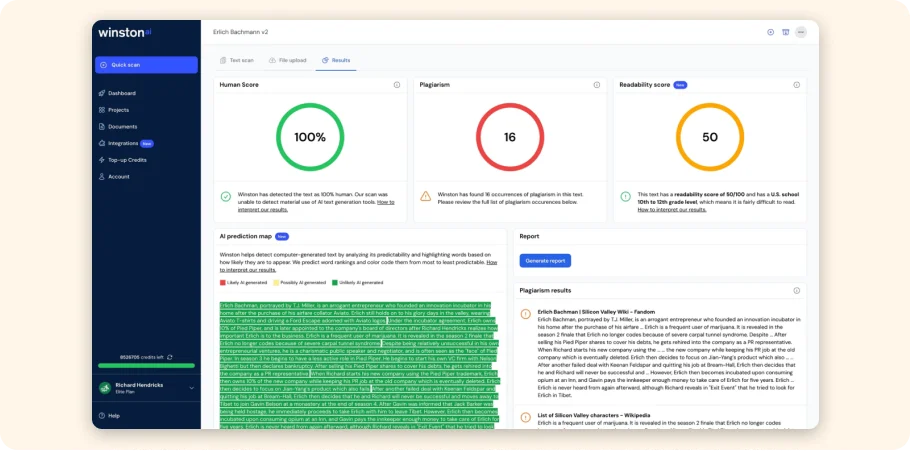
Winston AI has tools to detect ai written text in academic submissions. It is one of the best ai tools for teaching.
Features:
- Advanced Algorithms: Uses complex algorithms to analyze text deeply and find ai generated content.
- Custom Alerts: Educators can set up alerts when ai generated content is detected.
- High Accuracy: Known for its high accuracy in detecting AI-created content and human-written content.
Pros: Very good at detecting complex ai text.
Cons: May require more setup.
Pricing: Custom pricing based on institution’s needs.
9) Crossplag AI
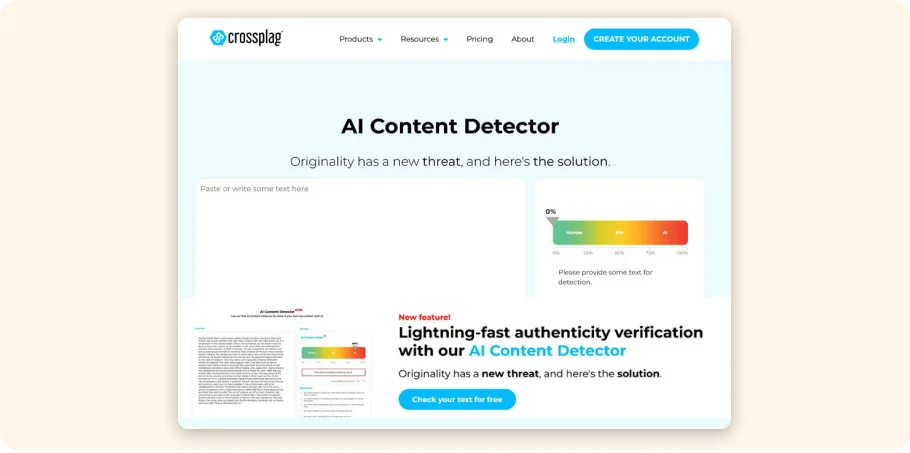
Crossplag AI checks for plagiarism and ai content detection to ensure content originality.
Features:
- Dual Functionality: Checks for plagiarism and ai generated content using advanced content detection tools.
- Database Access: Has a large database for cross checking content to enhance detection.
- User-Friendly Interface: Simple and easy to use interface for students and educators.
Pros: Covers all content integrity issues.
Cons: May be more features than smaller institutions need.
Pricing: Varies based on number of users and features needed.
10) Turnitin AI Checker
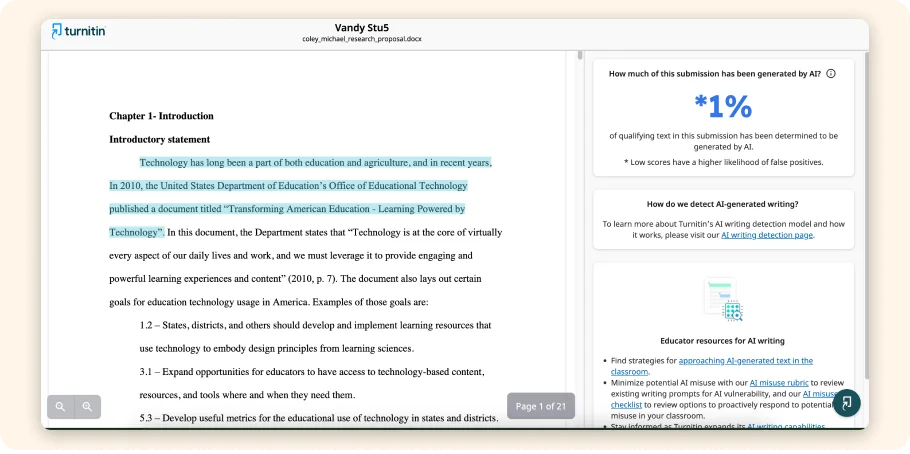
Turnitin AI Checker is built on Turnitin’s existing plagiarism detection reputation plus ai detection capabilities.
Features:
- Industry’s Largest Database: Uses one of the biggest academic database to compare and detect ai generated text.
- LMS Integration: Can be integrated into learning management systems for easy use.
- Detailed Reporting: Provides reports on where the text came from, ai generated or plagiarized.
Pros: Trusted by educators worldwide for accuracy and coverage.
Cons: Pricing may be a challenge for smaller institutions.
Pricing: Subscription based, varies based on institution size and usage.
Each of these tools has its own ai tool with different features to help educational institutions maintain the integrity of their academic work by detecting ai generated content and ensuring submissions are student authored.
What to Look for in Best AI Detection Tools
Accuracy:
An ai detection tool’s ability to detect ai generated content is key. High accuracy means human written content is recognized as such and ai generated content is flagged. Because even a small error rate means legitimate student work is flagged as ai generated or ai content slips through.
Ease of Integration:
Ai detection tools should be easy to integrate into existing systems, whether that’s a school’s learning management system (LMS) or content creation platform. Tools with a Chrome extension are particularly user friendly, users can activate the tool within their browser.
User Interface:
The ai detector tool interface should be simple and easy to use. Users, students and educators who may not be tech savvy need to be able to use the tool without extensive training. Ai detectors’ clear and simple interface ensures all users can manage and use the tool.
Language Support:
In today’s global educational landscape, language support is key. This feature allows ai content detectors to be used in different settings, to detect ai generated content in multiple languages, which is especially useful in multilingual schools or colleges.
Scalability:
As institutions grow or as the volume of student work increases, ai detection tools need to be able to scale up to handle more data without performance degradation. Scalability is important for larger institutions or online platforms that handle thousands of submissions.
Customization:
Different institutions have different needs based on their requirements. Customization options allow institutions to tailor the ai content detection tool to their needs, such as adjusting sensitivity or specifying what type of content to focus on.
Output Detector:
The tool should output its findings. Whether it’s through detailed reports or simple notifications, users should be able to understand what content was detected and why it was flagged as ai generated. This transparency helps in refining the detection process and teaching students about identifying ai generated content.
These features combined ensures ai content detector tools do their primary job of detecting ai content well and fit into the educational landscape, both teaching and learning. By considering these key points, institutions can choose ai detection tools that are powerful and practical.
How to Choose the Best AI Detection Tools
Choose the right ai detection tool for your institution:
Size of Your Institution:
The size of your institution is a key consideration when choosing an ai detection tool. Larger institutions may need a tool that can handle high volume of content quickly and efficiently. Smaller institutions may prioritize cost, perhaps opting for tools with free accounts or free models.
Types of Courses:
The types of courses you offer can also impact the type of ai detection tool you need. For courses with a lot of written content, such as humanities, the tool should be good at detecting nuances in human written text and differentiating it from ai generated content. For STEM courses, the tool may need to be able to handle formulas and code which have different detection parameters.
AI Detection Model:
Look into the ai detection model used by the tool. A good model should detect ai content and also provide an ai probability score, so you can make more informed decisions about the content’s authenticity.
Language Support:
Make sure the tool supports multiple languages if your institution has students from different language backgrounds. This is important for detecting ai generated content in different languages.
Can the Tool Bypass AI Detectors:
Some ai content generation tools are designed to bypass ai detectors. Test the ai content detection tools to see if they can counter this by detecting even the most advanced ai generated content.
Try Before You Buy:
Many ai content detection tools offer trial or demo versions. Use these to test how the tool integrates with your current systems and meets your needs. During the trial, pay attention to how well the free tool detects ai generated content and how user friendly it is.
Read Reviews and Ask for Recommendations:
Look at reviews from other institutions that have used the tools. This will give you an idea of how well the tool works and is reliable. Recommendations from edtech experts can also help you decide.
Cost and Subscription Model:
Finally, consider the cost vs your budget. Some tools are free to use, some offer more advanced features for a cost. Decide what features you need and if it’s worth the price.
By doing this you can choose an ai detection tool that meets your institution’s specific needs and enhances the educational integrity and quality of the courses you offer.
Conclusion:
Choosing the right ai detection tool is key to keeping educational content intact. These tools ensure that work submitted in schools and colleges is genuinely written by students, preserving the value of human written text. With ai technology and ai generation methods advancing, it’s more important than ever to use ai detectors that can detect natural and ai generated content.
When choosing an ai detection tool consider if it can detect content created by different ai models. Tools with advanced natural language processing can give a deeper analysis and are more effective in detecting subtle nuances of ai generated text.
As you compare the options, remember your institution’s specific needs. The size of your institution, the variety of courses, and the language needs of your students are all important factors. Look for the best ai- detectors that has the right balance of features, usability and cost to support your educational objectives.
Get started for Free
Start for free today. Boost your sales by clicking the Get Started button. With CrmOne, you can manage leads, sales, and customer service all in one place.
